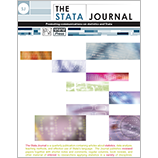Speaking Stata: Smoothing in various directions
Abstract. Identifying patterns in bivariate data on a scatterplot remains a basic
statistical problem, with special avor when both variables are on the same
footing. Ideas of double, diagonal, and polar smoothing inspired by Cleveland
and McGill’s 1984 paper in the Journal of the American Statistical
Association are revisited with various examples from environmental
datasets. Double smoothing means smoothing both y given x and
x given y. Diagonal smoothing means smoothing based on the sum
and difference of y and x that treats the two variables
symmetrically, possibly under standardization. Polar smoothing is based on
the transformation from Cartesian to polar coordinates followed by smoothing
and then reverse transformation; here the smoothing is implemented by
regression on a series of sine and cosine terms. These methods thus offer
exploratory tools for determining the broad structure of bivariate data.
View all articles by this author:
Nicholas J. Cox
View all articles with these keywords:
exploratory data analysis, statistical graphics, bivariate data, double smoothing, doublesm, diagonal smoothing, diagsm, polar smoothing, polarsm
Download citation: BibTeX RIS
Download citation and abstract: BibTeX RIS
|
